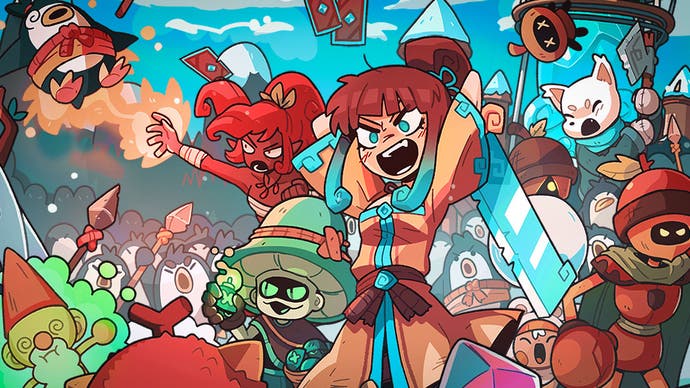What we've been playing
Cards, horror, draggable wreckage.
21st April, 2023
Hello! Welcome back to our regular feature where we write a little bit about some of the games we've found ourselves playing over the last few days. This time: cards, horror, and draggable wreckage.
If you fancy catching up on some of the older editions of What We've Been Playing, here's our archive.
Wildfrost, PC
I beat a Daily Voyage! That's the game's version of a daily challenge. And I can't tell you how happy I am about it. Well, I can actually - I am happy about it. There, done.
I'm happy about it because Wildfrost is hard, and that's one of things I love about it. It might look cute but it sure don't play cute. And the daily challenges are arguably the harder part of it. You get a pre-built deck to take as far as you can, and you can add to it your way but the base build is the same for everyone, and there are some modifiers in play too.
What this means is you need to look at what someone else has built, for a particular reason, normally, and work out what it is they're trying to do with it - and therefore, what you can do with it. There's a synergy there, you just have to try and see it.
I love that the game has me talking like this. It means there are tactical possibilities in the game and they are deep. And what I love even more - what I am even happier about, to keep the theme going - is that those possibilities feel very much its own. And that's not something you say about card battlers very often these days. I'm impressed.
Bertie
World of Horror, PC
World of Horror's basic pitch is wonderfully niche in its specificity: what if a roguelike version of Arkham Horror the board game, but with an aesthetic inspired by manga artist Junji Ito and filtered through the retro lens of an Apple Macintosh? Yet it works beautifully.
The basic gist is you're one of several selectable characters (each with their own subtle ability variants) investigating a number of narrative mysteries in a town tied to some malevolent cosmic awakening. Success comes once you've solved five mysteries - from haunted bulletin board systems to fertiliser of dubious origins, all drawing inspiration from Ito's distinct brand of the mundane run amok - without succumbing to a horrible death.
Each playthrough is randomly generated from a pool of pre-written mysteries, and each of those gains variety from a random stack of possible events you'll encounter along the way. Most mysteries have their own subtle structural quirks - you might, for instance, need to perform a ritual at a wake before dawn breaks - but all unfold by visiting different locations and attempting to mitigate whatever horrifying random events come to pass, whether that be an encroaching madness from another plane of existence, an unsettling monster attack, or simply just a bit of flavour text proferring a helpful item for later use.
There're more wrinkles to it than that, from hireable helpers and a post-mystery hub where you can plan and prepare for your next investigation (or have a bath!), and it doesn't always gel - the random nature of events can mean you're suddenly investigating a classroom in the middle of a haunted house - but the overall effect is wonderfully atmospheric, making for a more-ishly malleable horror yarn that manages to be unsettlingly off-kilter throughout. Better still, it's brilliantly modular, with bags of potential for expansion even in early access thanks to some increasingly robust mod support.
Matt Wales
ARTIFICIAL, PC
There’s no shortage of new and forthcoming space games right now, but I wonder if we’ve overlooked a budding subgenre in games set inside comets and asteroids, like Ghost Ship's Deep Rock Galactic, or ARTIFICIAL from solo developer Ondrej Angelovic.
I’ve been playing the latter's Steam demo, and am impressed by how it stands apart from your Callistos and your Dead Spaces. Each separately loading interior is a little greenish cave full of draggable, throwable wreckage. It’s first-person and you have a helmet HUD which lends a lovely, scratched-glass texture to the environment. I’m less keen on the puzzles or the world-weary radio guy who walks you through them, but still – this is the point on the Venn diagram between “Mines of Moria” and “Event Horizon” I didn’t know I needed.
Edwin Evans-Thirlwell




